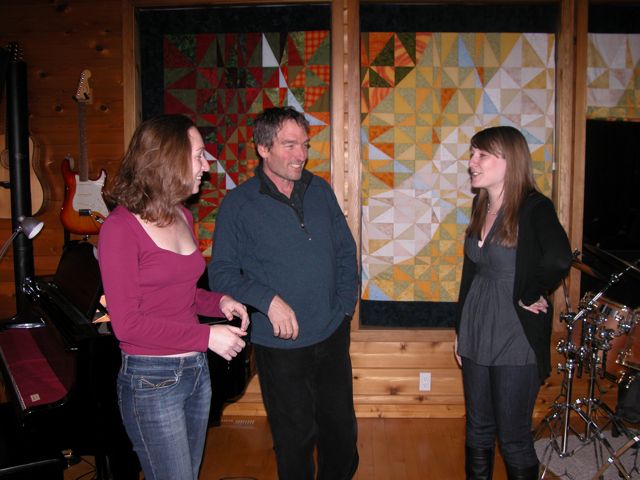Mya-Moe trivia
What's up with your headstock design?
When Gordon was building the first custom ukulele, he wanted Char's help designing a shape for the headstock. She, who was at the time still making hand-pieced roman shades, said that maybe it would be better to have a custom overlay instead of a shape. Gordon scoffed at her (of course), remarking that it would be way too hard to implement. Char explained how it could be done (based on how she made the shades) and Gordon saw the potential.

The picture on the left is Gordon with his two daughters (Kristy & Jenny) with Char's shades in the background.
This ranks among the top 5 best things that ever happened to Mya-Moe Ukuleles. Each headstock is unique (the overlay is glued up differently and/or rotated differently), yet they all are instantly recognizable. You can be in an audience of thousands, and that headstock jumps out from on-stage.
We do, upon request, provide other versions of the headstock including higher contrast (ebony/maple) and lower contrast (cherry/maple). We also will do a standard headstock and match it to the body wood.
Where did the name "Mya-Moe" come from?
Moe Dixon (professional touring musician) owns one of Gordon's early guitars. In January 2008, Moe asked Gordon to build him a custom ukulele. Early on, Moe played every ukulele that Gordon & Char made.
When we decided to give the ukuleles their own name (to differentiate them from the guitars), we wanted something that sounded vaguely Hawaiian, and we wanted to pay homage to the inspiration and help that Moe had provided. So, we thought of combining our names in some way. Let's see... ...Gordon-Moe, no... ...Mayer-Dixon, not really... ...but maybe some play on Mayer-Moe...
So we rearranged the first 3 letters in "Mayer", came up with Mya-Moe, and changed the pronunciation of Moe to "Mo-a (long a-sound)". Originally we put an accent over the "e" in Moe, but quickly realized that it was very hard to do an internet search on that, so we dropped the accent but still pronounce it the same way.
What's the serial number of the first ukulele, and why?
19. It was the 19th stringed instrument that Gordon had built (a koa classic owned by Moe). The second ukulele was #21 (a koa resonator, owned by Moe originally, and now Tommy Shreve). The third one was #26 (a koa resonator owned by Larry Wyatt) and they are sequential after that.
During the time that Gordon built the first 3 ukuleles, he completed a jazz guitar, a classical guitar, and 3 f-type mandolins. Don't ask him to build any of those instruments. He & Char now exclusively build ukuleles.
To this day, if you want to know what number ukulele you own, subtract 23 from the serial number to account for the other stringed instruments Gordon built.
What was the first custom ukulele that Char named?
"The Goddess", owned by Le Hanson. It is a Camatillo Rosewood classic.
Who was the first person to purchase a Mya-Moe?
Ray Fair, whom we lost in late 2009 to melanoma. Moe, Char and Gordon were visiting Artichoke Music (a Portland music store) in mid-2008 to show them the early ukes. They had two that were completed (a classic and a resonator), and a few bodies in mid-construction, one of which was a Zebrawood Classic. Ray walked in off the street looking for a higher-end uke. He saw the half-finished Zebrawood, and bought it on the spot.
Ray willed that instrument back to us, and it now hangs proudly on our wall.
What's the serial number of the first ukulele that Cary built?
The first ukulele that Cary built was never labeled or given a serial number. That instrument was gifted to Cary's sister, Ellen Kelly, and typically resides behind the bar at The Noble Fir, a tap room in the Ballard neighborhood of Seattle owned and operated by Ellen and her husband Rick. The first serialized Mya-Moe built by Cary is #2524 and was purchased by Mya-Moe enthusiast, Kathryn V.
What's the most popular tonewood for Mya-Moe?
The most popular wood choice for top, back and sides is Myrtle. Mya-Moe was an early pioneer of using Myrtle as a tonewood and now it can be found is use by several other ukulele and guitar builders. Myrtle provides a well-balanced acoustic response and has an aesthetic that can be very striking with varied grain patterns and some intense curl or flame. Koa is a close second and remains popular for is warm tone, natural beauty and traditional ukulele heritage. When a soft top is chosen, Spruce is the leader followed by Port Orford Cedar. You can find out more about how many ukes were built using various wood combinations by checking out our Gallery
How many instruments are in each batch?
Trick question. Cary doesn't build in batches. Each instrument is started and completed seperately and takes about 14 working days to build. At any given time, 4-6 instruments may be in the shop, but all in various stages of the process, from just beginning to nearing completion. You can check out the current state of the shop on the Mya-Moe ShopTracker page.
